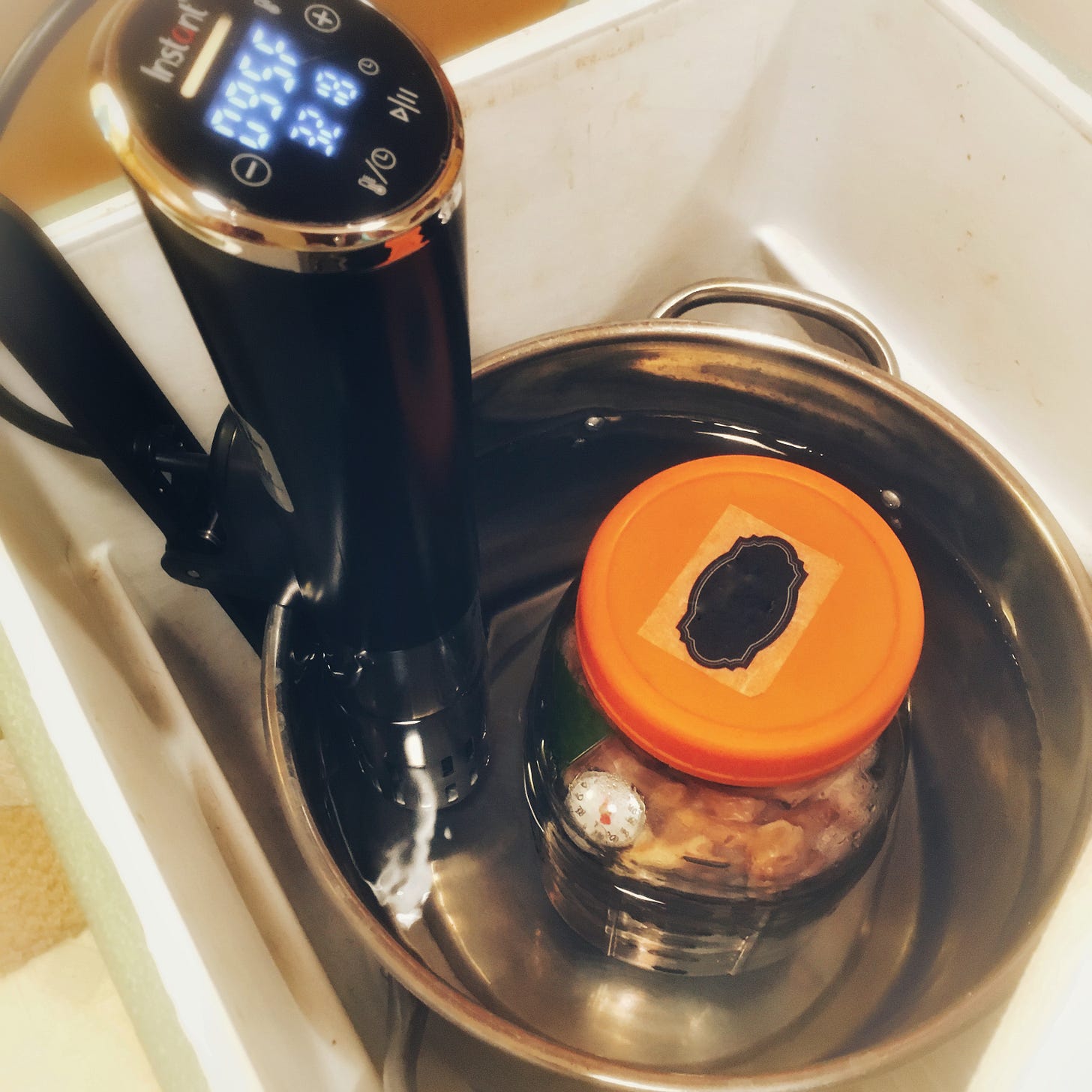The trouble with tiny cacao ferments, of a few to a few hundred pods, is the difficulty of the fermentation to reach a high enough temperature to cause the proper chemical changes. Over the last decade, I’ve practiced ways to add heat to tiny ferments with outstanding results. In my book One Cacao Tree, I give detailed information on how to use the simplest of equipment, a cooler and hot water in jars, to mimic the conditions of a large ferment. In the book I mentioned that a sous vide should in theory also work, but I hadn’t tried for lack of a machine. Well now I have tried it out.

I recently bought a sous vide machine* as research for my online mini-course on chocolate tempering. When life unexpectedly handed me ten cacao pods last month, I enthusiastically embraced the chance to give it a try.
Sous vide machines consist of a heating element, a thermostat, and a water circulator to keep a water bath at a constant temperature. The huge advantage of a sous vide is that you don’t have to reheat water throughout each day to keep the ferment warm. Instead, you occasionally check to make sure the water level is ok and that the timer isn’t in danger of running down. Once a day you mix, aerate, and observe the progress, and that’s it.
When using hot water jars, the ferment is heated through contact with warm air, but the sous vide hears the ferment through warm water contact. This water-bath transfer of heat is much more efficient, giving you more control over the temperature in the fermentation. This is great, but with great power comes great responsibility. The temperature can be exactly anything you’d like. But what exactly?
I set the water bath for 95°F for the first few days. This is a good temperature for yeasts to do their part of turning the sugar to alcohol. The ferment gave signs that this choice was good, having copious bubbles and an alcoholic flavor and smell.
After a couple of days, the sweet taste faded. At this point I started mixing the ferment once a day to encourage the bacteria that should dominate the next phase. Not knowing how slowly I should ramp the temperature, I turned the heat to 110°F for a day, then 120°F until day 8. The fermentation hit the sensory cues I usually look for: a darkening of the ferment, groves and gravy in the seeds, and a change in taste and smell. But these changes were a bit slower than I generally would expect, perhaps a day or two behind. On day 8 I cracked the temperature to 125°F for a day to encourage endogenous enzyme activity, then stopped the ferment because it would be inconvenient to my schedule to let it go longer.
While I suspect my temperature protocol needs to be refined, I am impressed at how great the seeds look given the tiny size of 10 pods.

While this is the first time I tried a sous vide for fermenting cacao, I know I’m late to this epiphany of ease, and others regularly use this method. Do you? If so, What is your temperature protocol? How are your results?
* Heartfelt gratitude to my paid subscribers who allow me to purchase new equipment to play with and pass on what I learn to you!
News
The chocolate tempering class I’ve been working on forever should be done in a week. Look for the special discount I’ll be offering to my subscribers!
Catch me on KCRW’s Good Food on this Saturday October 19 at 10am PDT. (7am here but that doesn’t mean I won’t be listening live with a cup of home grown/made chocolate in my cup!) Listen live online here or wait until I post the podcast version.





I'm fermenting with my Anova Sous Vide right now. I see it to 120 from the start. I can definitely smell a chocolate smell when I open the jars. The jar of all Trinitario was the first to have a scent. The other jar has a few Trinitario, but is mostly Forastero seeds that were much drier. Today, which is Day 3, it is starting to smell the same as the first jar. I received your book One Cacao Tree today and am diving into it. I've been growing Theobroma cacao here in Indiana, indoors, since the early 2000's.
Currently on day 3 of fermenting some cacao using my joule sous vide! I’m finally starting to get some color and alcohol forming and I’ve been keeping my beans at around 111-112 degrees. I read the ideal fermentation only lasts about 3 days but my beans definitely need more time. So nice to read others experimenting at home as well! 💗🍫